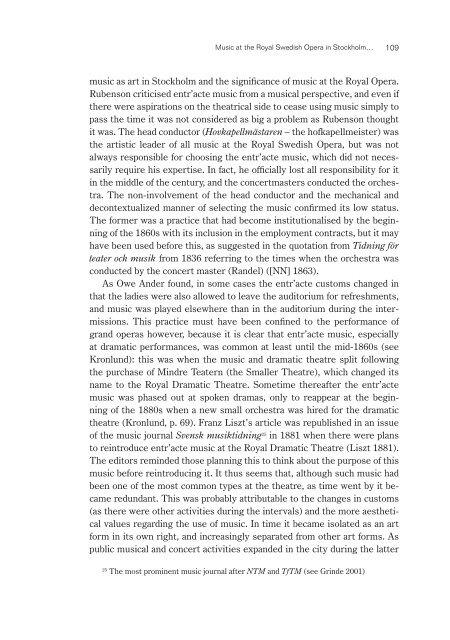Opera on the Move in the Nordic Countries during the Long 19th ...
Opera on the Move in the Nordic Countries during the Long 19th ...
Opera on the Move in the Nordic Countries during the Long 19th ...
Create successful ePaper yourself
Turn your PDF publications into a flip-book with our unique Google optimized e-Paper software.
Music at <strong>the</strong> Royal Swedish <str<strong>on</strong>g>Opera</str<strong>on</strong>g> <strong>in</strong> Stockholm…<br />
109<br />
music as art <strong>in</strong> Stockholm and <strong>the</strong> significance of music at <strong>the</strong> Royal <str<strong>on</strong>g>Opera</str<strong>on</strong>g>.<br />
Rubens<strong>on</strong> criticised entr’acte music from a musical perspective, and even if<br />
<strong>the</strong>re were aspirati<strong>on</strong>s <strong>on</strong> <strong>the</strong> <strong>the</strong>atrical side to cease us<strong>in</strong>g music simply to<br />
pass <strong>the</strong> time it was not c<strong>on</strong>sidered as big a problem as Rubens<strong>on</strong> thought<br />
it was. The head c<strong>on</strong>ductor (Hovkapellmästaren – <strong>the</strong> hofkapellmeister) was<br />
<strong>the</strong> artistic leader of all music at <strong>the</strong> Royal Swedish <str<strong>on</strong>g>Opera</str<strong>on</strong>g>, but was not<br />
always resp<strong>on</strong>sible for choos<strong>in</strong>g <strong>the</strong> entr’acte music, which did not necessarily<br />
require his expertise. In fact, he officially lost all resp<strong>on</strong>sibility for it<br />
<strong>in</strong> <strong>the</strong> middle of <strong>the</strong> century, and <strong>the</strong> c<strong>on</strong>certmasters c<strong>on</strong>ducted <strong>the</strong> orchestra.<br />
The n<strong>on</strong>-<strong>in</strong>volvement of <strong>the</strong> head c<strong>on</strong>ductor and <strong>the</strong> mechanical and<br />
dec<strong>on</strong>textualized manner of select<strong>in</strong>g <strong>the</strong> music c<strong>on</strong>firmed its low status.<br />
The former was a practice that had become <strong>in</strong>stituti<strong>on</strong>alised by <strong>the</strong> beg<strong>in</strong>n<strong>in</strong>g<br />
of <strong>the</strong> 1860s with its <strong>in</strong>clusi<strong>on</strong> <strong>in</strong> <strong>the</strong> employment c<strong>on</strong>tracts, but it may<br />
have been used before this, as suggested <strong>in</strong> <strong>the</strong> quotati<strong>on</strong> from Tidn<strong>in</strong>g för<br />
teater och musik from 1836 referr<strong>in</strong>g to <strong>the</strong> times when <strong>the</strong> orchestra was<br />
c<strong>on</strong>ducted by <strong>the</strong> c<strong>on</strong>cert master (Randel) ([NN] 1863).<br />
As Owe Ander found, <strong>in</strong> some cases <strong>the</strong> entr’acte customs changed <strong>in</strong><br />
that <strong>the</strong> ladies were also allowed to leave <strong>the</strong> auditorium for refreshments,<br />
and music was played elsewhere than <strong>in</strong> <strong>the</strong> auditorium dur<strong>in</strong>g <strong>the</strong> <strong>in</strong>termissi<strong>on</strong>s.<br />
This practice must have been c<strong>on</strong>f<strong>in</strong>ed to <strong>the</strong> performance of<br />
grand operas however, because it is clear that entr’acte music, especially<br />
at dramatic performances, was comm<strong>on</strong> at least until <strong>the</strong> mid-1860s (see<br />
Kr<strong>on</strong>lund): this was when <strong>the</strong> music and dramatic <strong>the</strong>atre split follow<strong>in</strong>g<br />
<strong>the</strong> purchase of M<strong>in</strong>dre Teatern (<strong>the</strong> Smaller Theatre), which changed its<br />
name to <strong>the</strong> Royal Dramatic Theatre. Sometime <strong>the</strong>reafter <strong>the</strong> entr’acte<br />
music was phased out at spoken dramas, <strong>on</strong>ly to reappear at <strong>the</strong> beg<strong>in</strong>n<strong>in</strong>g<br />
of <strong>the</strong> 1880s when a new small orchestra was hired for <strong>the</strong> dramatic<br />
<strong>the</strong>atre (Kr<strong>on</strong>lund, p. 69). Franz Liszt’s article was republished <strong>in</strong> an issue<br />
of <strong>the</strong> music journal Svensk musiktidn<strong>in</strong>g 25 <strong>in</strong> 1881 when <strong>the</strong>re were plans<br />
to re<strong>in</strong>troduce entr’acte music at <strong>the</strong> Royal Dramatic Theatre (Liszt 1881).<br />
The editors rem<strong>in</strong>ded those plann<strong>in</strong>g this to th<strong>in</strong>k about <strong>the</strong> purpose of this<br />
music before re<strong>in</strong>troduc<strong>in</strong>g it. It thus seems that, although such music had<br />
been <strong>on</strong>e of <strong>the</strong> most comm<strong>on</strong> types at <strong>the</strong> <strong>the</strong>atre, as time went by it became<br />
redundant. This was probably attributable to <strong>the</strong> changes <strong>in</strong> customs<br />
(as <strong>the</strong>re were o<strong>the</strong>r activities dur<strong>in</strong>g <strong>the</strong> <strong>in</strong>tervals) and <strong>the</strong> more aes<strong>the</strong>tical<br />
values regard<strong>in</strong>g <strong>the</strong> use of music. In time it became isolated as an art<br />
form <strong>in</strong> its own right, and <strong>in</strong>creas<strong>in</strong>gly separated from o<strong>the</strong>r art forms. As<br />
public musical and c<strong>on</strong>cert activities expanded <strong>in</strong> <strong>the</strong> city dur<strong>in</strong>g <strong>the</strong> latter<br />
25 The most prom<strong>in</strong>ent music journal after NTM and TfTM (see Gr<strong>in</strong>de 2001)
















